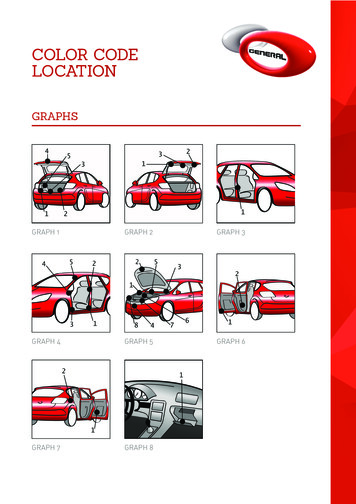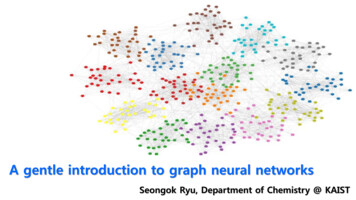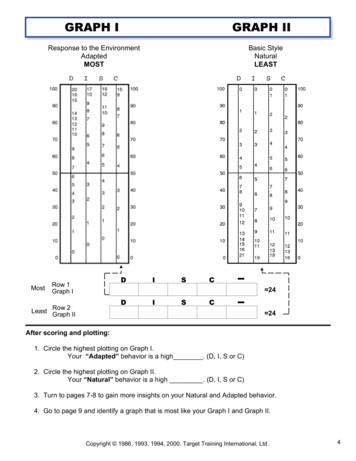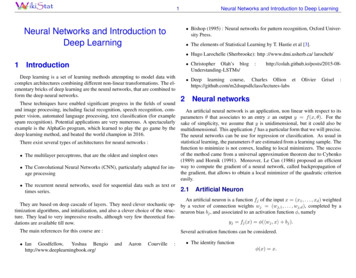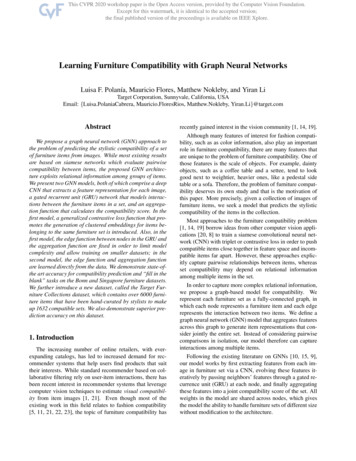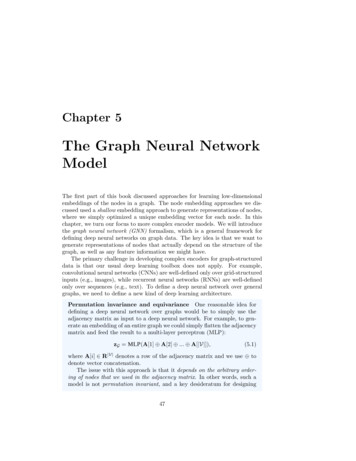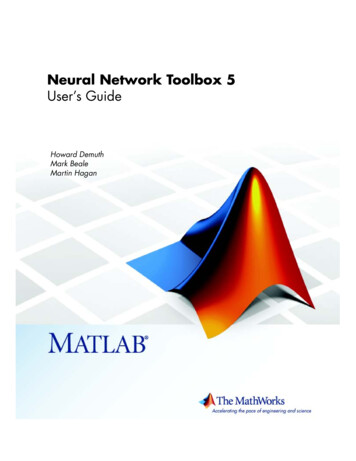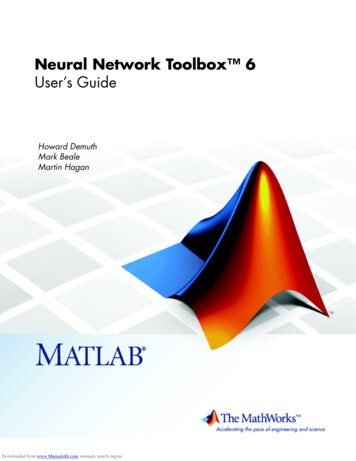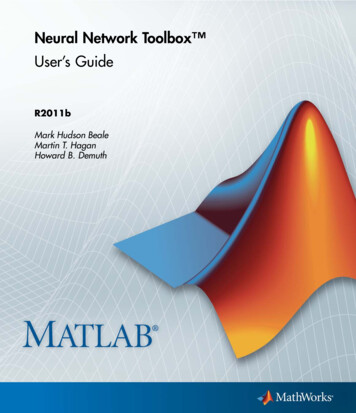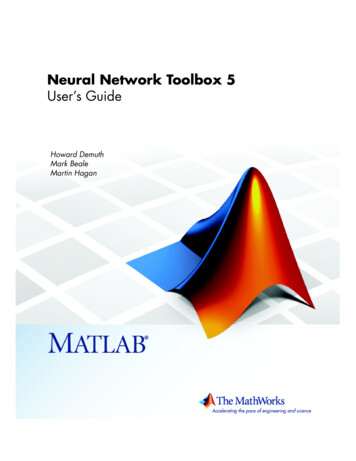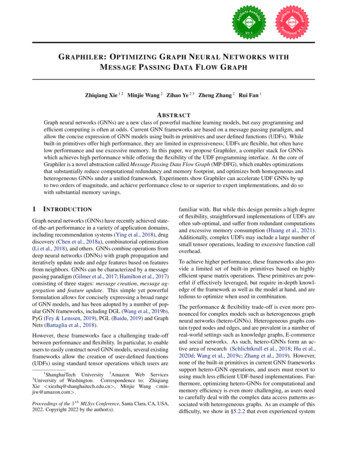
Transcription
G RAPHILER : O PTIMIZING G RAPH N EURAL N ETWORKS WITHM ESSAGE PASSING DATA F LOW G RAPHZhiqiang Xie 1 2 Minjie Wang 2 Zihao Ye 2 3 Zheng Zhang 2 Rui Fan 1A BSTRACTGraph neural networks (GNNs) are a new class of powerful machine learning models, but easy programming andefficient computing is often at odds. Current GNN frameworks are based on a message passing paradigm, andallow the concise expression of GNN models using built-in primitives and user defined functions (UDFs). Whilebuilt-in primitives offer high performance, they are limited in expressiveness; UDFs are flexible, but often havelow performance and use excessive memory. In this paper, we propose Graphiler, a compiler stack for GNNswhich achieves high performance while offering the flexibility of the UDF programming interface. At the core ofGraphiler is a novel abstraction called Message Passing Data Flow Graph (MP-DFG), which enables optimizationsthat substantially reduce computational redundancy and memory footprint, and optimizes both homogeneous andheterogeneous GNNs under a unified framework. Experiments show Graphiler can accelerate UDF GNNs by upto two orders of magnitude, and achieve performance close to or superior to expert implementations, and do sowith substantial memory savings.1I NTRODUCTIONGraph neural networks (GNNs) have recently achieved stateof-the-art performance in a variety of application domains,including recommendation systems (Ying et al., 2018), drugdiscovery (Chen et al., 2018a), combinatorial optimization(Li et al., 2018), and others. GNNs combine operations fromdeep neural networks (DNNs) with graph propagation anditeratively update node and edge features based on featuresfrom neighbors. GNNs can be characterized by a messagepassing paradigm (Gilmer et al., 2017; Hamilton et al., 2017)consisting of three stages: message creation, message aggregation and feature update. This simple yet powerfulformulation allows for concisely expressing a broad rangeof GNN models, and has been adopted by a number of popular GNN frameworks, including DGL (Wang et al., 2019b),PyG (Fey & Lenssen, 2019), PGL (Baidu, 2019) and GraphNets (Battaglia et al., 2018).However, these frameworks face a challenging trade-offbetween performance and flexibility. In particular, to enableusers to easily construct novel GNN models, several existingframeworks allow the creation of user-defined functions(UDFs) using standard tensor operations which users are1ShanghaiTech University 2 Amazon Web ServicesUniversity of Washington. Correspondence to: ZhiqiangXie xiezhq@shanghaitech.edu.cn , Minjie Wang minjiw@amazon.com .3Proceedings of the 5 th MLSys Conference, Santa Clara, CA, USA,2022. Copyright 2022 by the author(s).familiar with. But while this design permits a high degreeof flexibility, straightforward implementations of UDFs areoften sub-optimal, and suffer from redundant computationsand excessive memory consumption (Huang et al., 2021).Additionally, complex UDFs may include a large number ofsmall tensor operations, leading to excessive function calloverhead.To achieve higher performance, these frameworks also provide a limited set of built-in primitives based on highlyefficient sparse matrix operations. These primitives are powerful if effectively leveraged, but require in-depth knowledge of the framework as well as the model at hand, and aretedious to optimize when used in combination.The performance & flexibility trade-off is even more pronounced for complex models such as heterogeneous graphneural networks (hetero-GNNs). Heterogeneous graphs contain typed nodes and edges, and are prevalent in a number ofreal-world settings such as knowledge graphs, E-commerceand social networks. As such, hetero-GNNs form an active area of research (Schlichtkrull et al., 2018; Hu et al.,2020d; Wang et al., 2019c; Zhang et al., 2019). However,none of the built-in primitives in current GNN frameworkssupport hetero-GNN operations, and users must resort tousing much less efficient UDF-based implementations. Furthermore, optimizing hetero-GNNs for computational andmemory efficiency is even more challenging, as users needto carefully deal with the complex data access patterns associated with heterogeneous graphs. As an example of thisdifficulty, we show in §5.2.2 that even experienced system
Graphilerdevelopers often produce sub-optimal hetero-GNN implementations.In this paper, we propose Graphiler, a GNN compiler whichautomatically compiles GNNs defined using UDFs into efficient execution plans, which allows creating high performance models while retaining the expressiveness of theUDF interface. At the core of Graphiler is a novel abstraction called message passing data flow graph (MP-DFG),which enriches traditional DFGs with graph-based messagepassing semantics. MP-DFG uses semantic informationfrom message passing UDF signatures to deduce data movement patterns in the computation, then applies a number ofpowerful optimizations based on these patterns. For example, MP-DFG allows detecting opportunities for broadcastreordering or fusion, which can significantly reduce redundant computations and memory accesses. Our abstractionalso generalizes naturally to hetero-GNNs, allowing themto share data structures and kernels originally designed forhomogeneous GNNs, and enabling the automated discoveryof previously unexplored optimizations.We evaluate the effectiveness of Graphiler by using it tocompile a number of state-of-the-art GNN and hetero-GNNmodels written using UDFs. The results show that Graphilercan accelerate the models by up to two orders of magnitude,and achieve performance on par with or sometimes superior to implementations written and tuned by expert usersusing built-in primitives. On hetero-GNNs, Graphiler canoutperform state-of-the-art implementations by up to 7.9 .2BACKGROUNDIn this section, we provide an overview of the message passing paradigm for GNNs and hetero-GNNs, and introducetwo running examples we will refer to in the remainder ofthe paper.2.1Message Passing Paradigm for GNNsLet G (V, E) be a graph with node set V and edge setE. Each node u V is associated with a feature vectorxu Rfv , and each edge (u, e, v) E 1 is associated witha feature vector we Rfe , where fv and fe are the feature dimensions. The message passing paradigm for GNNsconsists of three stages:mehvxnewv φ (xu , xv , we ) , (u, e, v) E,ρ ({me : (u, e, v) E}) ,ψ (xv , hv ) , v V.Message creation Each edge produces a message by applying an edge-wise message function φ to its own1We follow the notation adopted in (Wang et al., 2019b), wheree represents the ID of the edge.features and the features of its two endpoints.Message aggregation Each node aggregates the messagesfrom incoming edges using an aggregation function ρ.Feature update Each node updates its features using anode-wise update function ψ.The preceding model is defined for homogeneous graphs,but can be extended naturally to heterogeneous graphs withmultiple node and edge types. An example of a heterogeneous graph is for modeling a citation network. Here wecan define two types of nodes, authors and papers, as wellas two types of edges, the first between an author node and apaper node representing authorship, and the second betweena pair of paper nodes representing a citation. Formally, wedefine a heterogeneous graph as HG (V, E, A, R). Vand E again represent nodes and edges, and A and R arefinite sets representing node and edge types, resp. We definefunctions τ : V A and ϕ : E R mapping each nodeor edge to its type. In addition, each type κ A R isassociated with a weight tensor wκ . The message passingparadigm for hetero-GNNs can then be defined as follows: me φ xu , xv , we , wτ (u) , wτ (v) , wϕ(e) , (u, e, v) E,hv ρ ({me : (u, e, v) E}) ,xnew ψ xv , hv , wτ (v) , v V.v2.2Running Examples: GAT and HGTWe now describe the widely used graph attention network(GAT) (Velickovic et al., 2018) GNN, and its hetero-GNNcounterpart heterogeneous graph transformer (HGT) (Huet al., 2020d), in order to help illustrate the design andcapabilities of Graphiler. The main difference betweenthese two models lies in the message creation stage. Givenan edge j i, the node and edge messages for the edge inGAT are given by:mj iej i zj W hj ,LeakyReLU (W(1)AT T(zi zj )),(2)HGT was inspired by the design of Transformers (Vaswaniet al., 2017), and maps the features of each node i intoQuery, Key and Value vectors using matrices WτK(i) , WτQ(i)and WτV(i) based on the node’s type τ (i) (Equation (3)).To incorporate relational information, it further introducesAT TM SGtwo weight matrices Wϕ(j i)and Wϕ(j i)associated edgej i’s type ϕ(j i) (Equations (4) and (5)):Kj , Qi , Vj WτK(j) hj , WτQ(i) hi , WτV(j) hj ,(3)mj i M SGWϕ(j i)Vj ,(4) AT TKj Wϕ(j i)QTi ,(5)ej i
GraphilerGAT and HGT share the same message aggregation function,where each node receives messages from incoming edgesand produces an aggregated result r:αj i ri exp(ej i ),k N (i) exp(ek i )Xαj i mj i ,P(6)(7)j N (i)In the feature update stage, the features of each node areupdated by an activation function σ; for ease of exposition,we omit the complex update performed in HGT.hnewi3 σ(ri )(8)P ERFORMANCE P ROBLEMS OFC URRENT GNN S YSTEMSA key to the success of GNNs is the flexible choice ofthe message function φ, aggregation function ρ and updatefunction ψ in the message passing paradigm. Current GNNsystems allow users to express these functions natively inPython using tensor operators and then invoke them usingsystem provided APIs, a programming paradigm which wecall user-defined functions (UDFs). Figure 1(a) shows asimplified implementation of GAT and HGT in DGL’s UDFinterface, where each line of code is associated with anequation from §2.2. Other frameworks such as PyG adopta similar design. While UDFs is flexible and user-friendly,they can lead to significantly degraded performance. Thisforces these frameworks to provide efficient but much lessexpressive primitive operators.3.1Redundancy in message creationThe message creation UDF message hgt (lines 8-17) provides users an edge-centric view. Users can access the previously computed representations of an edge’s source anddestination nodes, the edge itself, and the parameter matrices associated with their types via methods from the edgesargument. All these methods internally gather data from thecorresponding storage tensors and pack them into a message tensor. For example, in line 10, edges.src[’h’]looks up the source node representation for each edge fromthe node tensor storing all the node representations. Likewise, edges.srctype[’Wk’] gathers the weight matrices based on the source node type of each edge, as illustratedin Figure 1(b). Because all the message tensors have size E in the leading dimension, the subsequent batch mm canperform many matrix multiplications in a batch.This approach for gathering data leads to a large amount ofredundancy. We show this using an example heterogeneouscitation network with two types of nodes (author and paper)and two types of edges (authorship and citation). The authorship edges connect author nodes to paper nodes, and thecitation edges connect two paper nodes. Figure 1(b) showsthe messages produced from different source data using different colors, and illustrates the data redundancy incurred.The redundancy can be severe in real-world graphs, becausemany nodes may share the same type (i.e. A V ) andnodes may have high degree (i.e. V E ).3.2Fragmented computation in message aggregationThe message aggregation UDF aggregate func (Figure 1(a), lines 19-24) provides users a node-centric view.Users can access the messages computed by the messagecreation UDF as well as the node representations usingthe node argument. Since nodes may have different degrees, they can receive different numbers of messages, andthis makes batching during aggregation difficult. To dealwith this, DGL internally shards the message tensor intomultiple pieces, with each piece grouping together nodesreceiving equal number of messages. This “bucketing”strategy makes it possible to apply arbitrary tensor operations inside an aggregation UDF. The system then invokesaggregate func on each message tensor shard to obtainthe aggregated messages of all the nodes. In a hetero-GNN,if a user wishes to aggregate messages differently for different node types, the system further shards the messagetensor based on destination node type and loops over them.However, sharding message tensors fragments the computation, and leads to performance issues such as low GPUutilization, large kernel launch overhead, etc.3.3Trading expressiveness for efficiencyTo circumvent the previous performance issues, all currentGNN frameworks choose to limit their expressiveness to various degrees. For instance, PyG forbids aggregation UDFsand thus avoids the problem of fragmented computation.DGL does, but recommends that users express their modelsusing a set of built-in message creation and aggregationprimitives. For example, if an aggregation UDF simply returns {’r’: sum(nodes.mailbox[’m’])}, it canbe replaced by dgl.sum(’m’, ’r’), which is executedusing an efficient sparse matrix kernel. In addition, if boththe message creation and aggregation functions are chosenfrom the built-in set, DGL fuses the two stages and completely bypasses any message creation. This can also beachieved in PyG using the message and aggregatefunction. However, DGL’s approach requires a large set ofbuilt-in primitives to achieve good model coverage, and theamount of engineering effort needed is often infeasible inpractice. For example, the HGT code in Figure 1(a) cannotbe constructed using the current DGL primitives.Moreover, even when it is feasible to program a model us-
']writetewritebatch 'cite',b)(a,'cite',b)(b)Figure 1: (a) GAT and HGT implementations in DGL UDFs. (b) A Toy heterogeneous graph and an illustration of themessage gathering process for code line 10.which reside on edges, while edges.srctype[’Wk’]converts weights which reside with node types to messageson edges. Similarly, message aggregation converts messageson edges to new node representations. Therefore, the mainalgorithmic problems Graphiler focuses on are detectingdata residency changes and deducing optimizations basedon the changes.4Figure 2: GAT implementation using DGL primitives.ing existing primitives, it is challenging for non-experts tounderstand and make good use of them. Figure 2 showshow DGL developers construct the GAT model withoutUDFs to achieve better performance. By comparing thiswith Figure 1(a), we can observe that users have to carefully manage data associated with nodes and edges in thesame scope, and additionally decompose familiar tensoroperators (e.g. concat and softmax) into efficient butnon-intuitive graph primitives.3.4SummaryWe observe that UDFs offer a high degree of expressivenessand work well as a user-facing interface. At the same time,built-in primitives are a good low-level interface targetingsystem efficiency. Therefore, we have built Graphiler as acompiler stack to build a bridge so as to offer the benefitsof both. A key insight in Graphiler’s design is that the mostcomputationally demanding parts of a GNN computation,namely message gathering and aggregation, can be associated with changes in data storage type, which we term dataresidency. For instance, edges.src[’h’] converts representations which conceptually reside at nodes to messagesD ESIGN OF G RAPHILERGraphiler centers around a novel intermediate representation (IR) that we call Message Passing Data Flow Graph(MP-DFG), which augments a classic DFG with residencyinformation about tensors and the movement pattern induced by operators. In this section, we first define dataresidency and data movement in §4.1, then describe howGraphiler builds an MP-DFG for a GNN program, in §4.2which enables two effective GNN optimizations in §4.3.4.1Message Passing Data Flow GraphA DFG is an acyclic graph with nodes and edges representing operators and the dependencies between them, respectively. Existing DNN compilers, including XLA (Google,2017), NNVM (DMLC, 2017) and JAX (Bradbury et al.,2018), have successfully leveraged this abstraction. Annotations such as data types and the shapes of intermediatetensors to enables optimization such as kernel fusion (Chenet al., 2018b), subgraph substitution (Jia et al., 2019), etc.The key insight of Graphiler is to extend DFG with messagepassing semantics that captures changes in data storage typeas the computation moves along, summarized in Figure 3:Data residency is an annotation that associates a variablewith the element of a graph, and there are five of them:node data DV , edge data DE , node type data DA , edge type
GraphilerDenseTable 1: Inference rules of data residency.N ormBroadcastSrc rc typeDADenseDRDenseDenseFigure 3: Transition graph for data residency in an MP-DFG.Edges represent data movement; edge direction indicatesthe residency of input and output data.data DR and shared data DS . The tensors of the first fourresidency types have V , E , A and R as the size of theirleading dimension, while the tensors of shared residencytype (e.g., GNN model weight matrices) can have arbitraryshapes since they are not directly related to the graph.Data movement is associated with each operator, indicating how the operator transforms the data residency of itsinput. Under the message passing paradigm, we categorizeeach operator into one of four classes: Broadcast operators convert data from residency type Dxto another residency type Dy by index look-up. For example, edges.srctype[’Wk’] (Figure 1, line 10)converts node type weights into an edge data tensor bylooking up the weight matrices of the source node type ofeach edge. Because broadcasting node data or node typedata into edge data can be based on either the source ordestination nodes of edges, we further distinguish themwith BroadcastSrc and BroadcastDst . Broadcast operators typically induce data duplication if Dy Dx . Reduce operators are the reverse, as for example in line23 in Figure 1, where the sum operator transforms theinput data of residency DE to output data of DV by aggregating edge data to a node. N orm operators work on edge data, combining two stepsin one by first aggregating edge data belonging to the samedestination node and then broadcasting the aggregatedresult back to the edges. Although the data residency ofthe output remains the same as that of the input, normoperators still perform data movements between nodesand edges internally. Dense operators are independent of the graph structureand generate no data movement. In other words, for inputsum, max, .with dim 1softmax, .with dim 1Other tensor opsLoc of CallMsg CreationMsg CreationMsg CreationMsg CreationMsg CreationMsg CreationMsg Aggr.Msg Aggr. ,Feat. UpdateMsg Aggr. ,Feat. UpdateData MovementF etch data : DEBroadcastSrc : DV DEBroadcastDst : DV DEBroadcastSrc : DA DEBroadcastDst : DA DEBroadcast : DR DEF etch data : DEMsg Aggr.Reduce : DE DVMsg Aggr.N orm : DE DEAnywhereDense : §4.1F etch data : DVBroadcast : DA DVdata with residency DV , DE , DA , or DR , the operatorwill not compute across the first dimension. The datamovement of unary dense operators is illustrated in Figure3. General dense operators take N inputs {x1 , ., xN },where each xi has data residency Di {DS , α}, forα {DV , DE , DA , DR }. It produces output data withresidency DS if all Di DS , and otherwise is α.4.2MP-DFG BuilderGraphiler first extracts a standard DFG from each UDFusing the tools such as TorchScript available for PyTorch (Paszke et al., 2019). Graphiler first determines thedata residencies for the root variables. This informationis explicitly or implicitly specified through interfaces provided by existing GNN frameworks (e.g., edges.src forbroadcasting node data to edge data, edges.srctype forbroadcasting node type data to edge data, etc.). Graphilerdetects these operations and annotates the input and outputdata residencies as well as their data movement types.Graphiler then infers the data movements of operators andthe residencies of subsequent output variables of the DFG ina topological order. In each step of this process, Graphileruses rules based on operator description, location of invocation (i.e., stage of message passing) and input data residencyto perform inference. These inference rules are listed inTable 1. Inference can fail if a user invokes either operatorsor APIs on data with invalid residency types, or invokescustomized operators whose data movements are unknown.In these cases, Graphiler will abort and fall back. Graphileralso supports expanding the rule set for customized operators and preparing these rules is onetime and lightweight.Once inference is completed, all variables and operatorswill have been populated with their respective residencyand movement types, and an MP-DFG is created. Figure 4shows the MP-DFG built by Graphiler from the GAT codesample. Using the MP-DFG formalism, Graphiler is able
Graphileredge datanode databroadcast opWz srcmmsoftmaxleaky relucathalphaebatch mmW msgBroadcast FusionW attedges.src z srcmmcatzmedges.typeBroadcast Reorderinghfused opr*z dstedges.dstmmshared datadense opvsummmWnorm opW attmmedges.srcedge type datanode type datareduce opsoftmaxleaky reluBroadcast FusionvalpharemW msgedges.dst z dst(a)(b)Figure 4: (a) Transformation on the MP-DFG of GAT. (b) Transformation on part of the MP-DFG of HGTto effectively model irregular data accesses in aggregationUDFs containing Reduce and N orm operators, and automatically replace regular tensor operators in UDFs withefficient primitives to remove the fragmented computationsdescribed in §3.2.4.3MP-DFG OptimizerGraphiler adopts a pattern matching approach to optimizeMP-DFGs. It iteratively traverses an MP-DFG to matchsubgraphs with predefined patterns and replace them withoptimized ones. By capturing the semantics of messagepassing computations, MP-DFGs enable several optimizations which can substantially accelerate GNN models. Herewe discuss two important optimization patterns.4.3.1Broadcast ReorderingAs discussed in §3.1, broadcast operations can introduceredundant computations. For instance, consider the twomatrix multiplications at line 3 in the GAT example, wherenode data gets scattered first and then multiplied. Supposethe node feature size is d1 and the weight matrix w has shaped1 d2 , this multiplication is O( E E d1 d2 ), where thefirst term is the cost of broadcasting node features ontoedges while the second term is for the matrix multiplication.The redundancy can be eliminated by changing the orderof the computation sequence as shown in Figure 4 (a), withthe same result but drop the complexity to O( V d1 d2 E )(since E V for most graphs): computing the matrixmultiplication first then broadcasting the outcome to edges.Formally, we define the following sub-graph substitutionrule:Source Pattern: y f (g(x)), where f and g are Denseand Broadcast operators respectively2 .Substitute Pattern: y g(f (x))Note that the substitution rule is applicable to both homogeneous and heterogeneous GNNs. For heterogeneous GNNs,it can appear when node and edge type data are broadcastedto edges. For example, the Simple-HGN model (Lv et al.,2021) computes a message of an edge by multiplying theedge type embedding with a weight matrix. This can be captured by matching x as an edge type data, g as an operatorof movement type Broadcast : DR DE and f as thematrix multiplication.4.3.2Broadcast FusionIn DNNs, the tensor produced by one operator is oftenimmediately consumed by a subsequent operator. Fusingthese two operators into one can greatly reduce memorybandwidth use and kernel launch overhead. This optimization applies to GNNs with even greater benefit because ofthe prevalence of broadcast operations that produces largeamount of data that are soon consumed by operators thatfollow. Fusing can often reduce the amount of memoryaccess and the memory footprint by O( E ). We separatethis optimization into two computation patterns:Broadcast-compute. An example can be found in Figure 4(b), which corresponds to the line 14 of HGT codein Figure 1(a). The intermediate edge data produced bythe broadcast operator edge.type soon gets consumedby the following batch mm. Suppose W msg has shape( R d1 d2 ). By fusing the broadcast operator with2For simplicity, we omit the arguments of shared data residencyfor all the Dense operators in the pattern description.
Graphilerbatch mm, the fused kernel is able to directly read fromW msg, eliminating an intermediate memory buffer of size E d1 d2 as well as the memory traffic to access it. We canformulate this sub-graph substitution rule as follows:Source Pattern: z f (g1 (x), y) or z f (x, g2 (y)) orz f (g1 (x), g2 (y)) , where f is an Dense operator, g1and g2 are Broadcast operators.Substitute Pattern: z F usedOp(x, y)Broadcast-compute-reduce. The pattern is common inmany message passing GNNs. GAT, for example, first looksup source node features onto edges, scales it by the edgeattention value and aggregates them into new node features.Expert developers usually rewrite it with framework provided primitives that fuse the three steps into one to avoidinstantiating the intermediate data of size O(E) (Figure 2,line 17). Graphiler automatically does so with the followingrule:Source Pattern: z ρ(f (g1 (x), g2 (y))) or z ρ(f (x, g2 (y))) or z ρ(f (g1 (x), y)), where ρ and f areReduce and Dense operators respectively; g1 and g2 areBroadcast operators.Substitute Pattern: z F usedOp(x, y)While recent works (Wang et al., 2019b; Huang et al., 2021;Wu et al., 2021) have explored these two types of fusionpatterns for homogeneous GNNs, they failed to identify thefusion opportunities in hetero-GNNs. With the help of MPDFG, we observe that all explored fusion patterns in priorworks are special cases of our rules, which allows Graphilerto seamlessly apply broadcast fusion to both homogeneousand heterogeneous GNNs.Fused Operator Implementation. Graphiler leverages arich set of primitives provided by DGL to serve as kernels offused operators. Therefore, Graphiler adopts sparse matrixrepresentations used in DGL as well, namely CSR and COO.As a result, load balancing is also largely handled by thesesparse computation kernels. In addition to that, we onlymanually implement a few commonly used kernels, e.g.,segmented matrix multiplication, for better coverage. Weleave efficient sparse matrix computation kernel generationas a future work.Besides the optimizations tailored to the message passingparadigm of GNNs, traditional DFG optimizations such asdead-code elimination, common sub-expression elimination,pattern matching and substitution, etc. are applicable to MPDFG as well.55.1E VALUATIONExperimental Setup and MethodologyBenchmark models and datasets. Our benchmarks arebased on a broad range of GNN models designed for nodeclassification tasks. These include the widely used GraphConvolutional Network (GCN) (Kipf & Welling, 2017), theattention-based model GAT (Velickovic et al., 2018), and animproved version of GAT called Constrained GAT (C-GAT)(Wang et al., 2019a). All three models are standard GNNsconsisting of a single node and edge type. For hetero-GNNs,we evaluated the popular R-GCN (Schlichtkrull et al., 2018)model, and the transformer-based HGT (Hu et al., 2020d)model, which achieves state-of-the-art accuracy. For allmodels, we follow standard practices and use two layerswith 64 dimensions in the hidden layer.We compare Graphiler with the following four baselines. DGL-UDF: A set of non-expert implementations written by DGL users using the UDF interface. These werecollected largely from the DGL forum. DGL-Primitives and PyG-Primitives: A set of expert implementations carefully engineered by DGL and PyGframework developers using primitive operators similarto the ones shown in Figure 2. These were collected fromthe official DGL and PyG repositories. Seastar (Wu et al., 2021) implementations: Seastar is a recent GNN framework with a similar pipeline to Graphiler,but based on a vertex-centric programming interface anda DFG-based IR.We validated our experimental results on ten graphs containing thousands to millions of nodes and drawn from a varietyof domains, as shown in Table 2. For homogeneous graphs,we considered Pubmed (Sen et al., 2008), ogbn-arxiv (Huet al., 2020a), PPI (Zitnik & Leskovec, 2017), and Reddit (Hamilton et al., 2017). For heterogeneous graphs, weconsidered MUTAG, BGS and AM from the Semantic WebDataset (Ristoski et al., 2016), and the ogbn-biokg datasetfrom the Open Graph Benchmark (Hu et al., 2020b).Machine environment. We conducted our experimentson an AWS p3.2xlarge instance equipped with an NVIDIATesla V100 GPU (16GB version) and Intel(R) Xeon(R)E5-2686 v4@2.30GHz CPUs. The software environmentincluded Ubuntu 20.04 and CUDA 11.1.We prototyped Graphiler using DGL v0.6.1 with a PyTorch1.8.2 backend. Our baselines consist of expert and nonexpert implementations in DGL v0.6.1 and PyTorch Geometric (PyG) 2.0.1. All reported performance numbers areaverages over 1,000 runs and exhibited low variance. Thecorrectness of programs compiled using Graphiler was verified by comparing their outputs with those from the originalUDF implementations. Each program was only compiledonce for different input graphs and the compilation onlytook seconds to complete.
G
ATT(z ijjz j)); (2) HGT was inspired by the design of Transformers (Vaswani et al.,2017), and maps the features of each node iinto Query, Key and Value vectors using matrices WK (i), W Q (i) and WV (i) based on the node's type (i) (Equation (3)). To incorporate relational information, it further introduces two weight matrices WATT .
